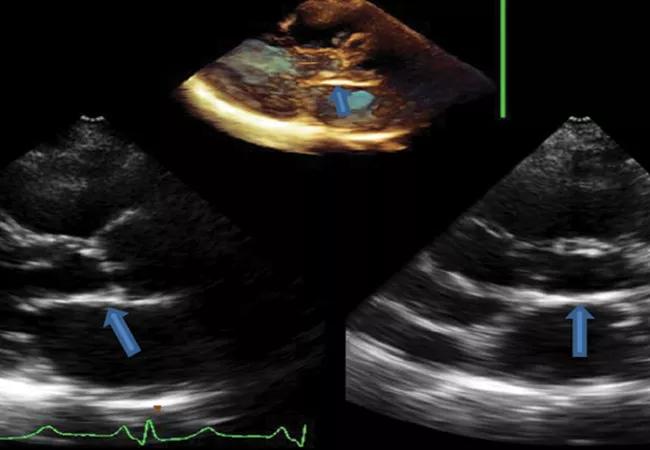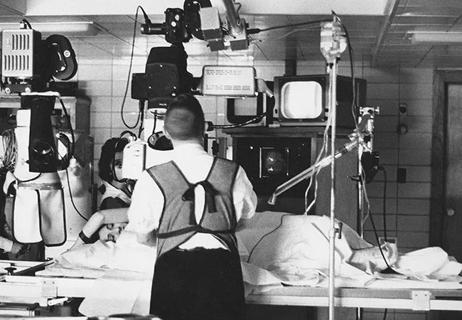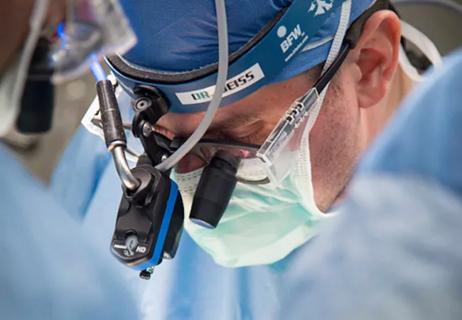Advertisement
Guidance to advance improved risk management

Advertisement
Cleveland Clinic is a non-profit academic medical center. Advertising on our site helps support our mission. We do not endorse non-Cleveland Clinic products or services. Policy
Advances in radiotherapy over the past 50 years have dramatically improved outcomes in patients with malignancy. Five-year overall survival rates for Hodgkin lymphoma and non-Hodgkin lymphoma now stand at 80 percent, and breast cancer survival is 90 percent.1
Increased longevity, however, has come at the cost of late side effects such as radiation-induced heart disease (RIHD). Cardiac dysfunction due to radiation involves a spectrum of disease processes in patients who have undergone mediastinal, thoracic or breast radiotherapy and may involve any cardiac structure, including the pericardium, myocardium, valves, conduction system and coronary arteries.
Overall, compared with nonirradiated patients, those who have undergone chest radiotherapy have a 2 percent higher absolute risk of cardiac morbidity and death at five years and a 23 percent increased absolute risk after 20 years.2
These data illustrate the stakes of optimal diagnosis and management of RIHD. My colleagues and I recently published a review of the pathophysiology, epidemiology and practical diagnosis and management of RIHD in the Cleveland Clinic Journal of Medicine.3 To advance improved identification of RIHD, this post excerpts portions of that article that focused on risk management of RIHD.
The volume of heart irradiated is a major determinant of the development of RIHD.4 A retrospective study of 960 breast cancer patients in Stockholm between 1971 and 1976 found that those who had received the highest doses and volumes of cardiac radiation had a threefold higher risk of cardiac death. By comparison, those with lesser volumes of the heart exposed to radiation had no increase in risk of cardiac death compared with the general population.5
Advertisement
Younger age at the time of radiotherapy is associated with an increased risk of RIHD in breast cancer and lymphoma patients. A retrospective analysis of 635 patients under age 21 with Hodgkin lymphoma treated with radiotherapy showed a relative risk of fatal myocardial infarction of 41.5 compared with a general population matched for age, sex and race.6
Conventional cardiac risk factors such as smoking, hypertension, diabetes and hyperlipidemia further increase the risk of RIHD, and radiation increases the cardiotoxicity of chemotherapeutic agents such as anthracyclines.7
In general, high-risk patients are defined8 as those who have undergone anterior or left-sided chest irradiation and have at least one of the following additional risk factors for RIHD:
Consensus guidelines for identifying and monitoring RIHD have been published by the European Association of Cardiovascular Imaging and the American Society of Echocardiography.8
Briefly, the guidelines call for aggressive cardiac risk-factor modification through weight management, exercise, blood pressure control and smoking cessation, in addition to early detection of RIHD. Cardiovascular screening for risk factors and a careful clinical examination should be performed in all patients. Baseline comprehensive transthoracic echocardiography is advocated in all patients before starting radiotherapy to detect cardiac anomalies. Beyond this, an annual history and physical examination, paying close attention to the signs and symptoms of cardiopulmonary disease, is recommended. The development of new cardiopulmonary symptoms or a new physical finding such as a murmur should prompt evaluation with appropriate testing.
Advertisement
As survival from breast cancer and lymphoma has increased, we continue to see legacy or latent effects of therapy, such as RIHD. Radiation therapy can affect any cardiac structure and can pose a major risk of morbidity and death for some cancer survivors.
Modern radiation techniques use a variety of mechanisms to decrease the radiation dose to the heart. With advances in radiotherapy and the development and widespread implementation of consensus guidelines, we envision earlier detection and less frequent occurrence of RIHD, although the latter trend could be blunted by increased cardiovascular risk factors within the population. Given the lag between irradiation and the cardiac consequences, it may be a number of years before any comparisons can be drawn.
It is recommended that patients with a history of prior radiotherapy seek subspecialist consultation before nonemergent cardiac interventions, as standard risk scores do not adequately reflect these patients’ periprocedural complication rates. Moreover, specific and more comprehensive preoperative testing is typically required.
The full version of the review article discussed above (by Donnellan E, Phelan D, McCarthy CP, Collier P, Desai M, Griffin B), published by Cleveland Clinic Journal of Medicine, is available here.
Advertisement
Dr. Collier is Co-Director of Cleveland Clinic’s Cardio-Oncology Center and a cardiologist in the Section of Cardiovascular Imaging.
Advertisement
Advertisement

How our first century has impacted cardiovascular practice

Review offers comprehensive assessment of the landscape for wearables and more

Preserving trust in research requires vigilance and consensus around statistical nuances

Cardiac surgeon Patrick Vargo, MD, reflects on his first year as Cleveland Clinic staff

Improved risk prediction for patients is at the heart of Dr. Aaron Weiss’ research interests

Centralization would likely bring better outcomes, experts say, but may not be feasible

JACC review makes the case and outlines how to ensure oversight

Editorial lays out best practices from three Cleveland Clinic surgeons